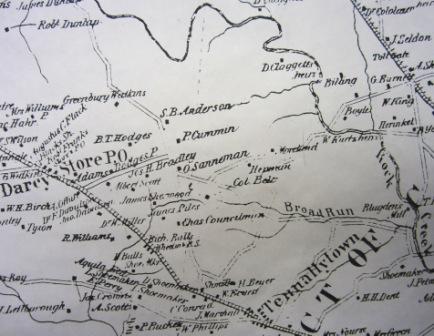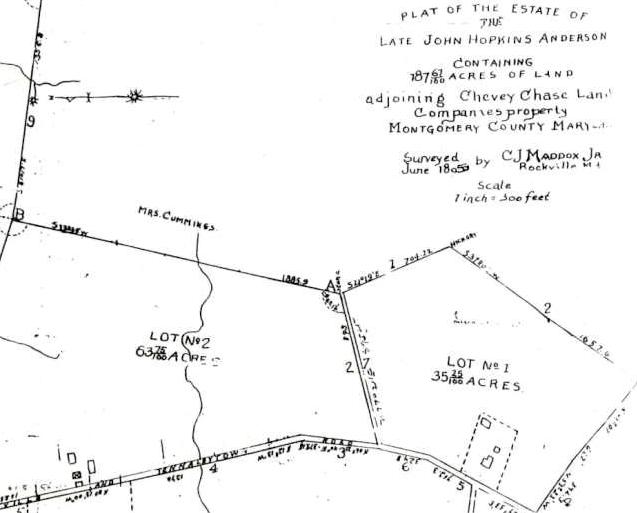100 Acres at the Maryland/District of Columbia Border

James and Patrick Cummings
In the nineteenth century, Chevy Chase was an agricultural area. Several large family farms and estates, such as the “No Gain” plantation, raised tobacco using slave labor in the years before the 1820s. Like other southern Montgomery County farmers, the proprietors of this large 300 acre farm switched from tobacco to grain as their cash crop. The economic challenges of this enterprise, both before and after the Civil War, would eventually force the sale of large parcels of the "No Gain" estate, the first steps in a process that would transform the landscape from farmland to a residential suburb. It would be developed in the 1890s as the new suburb called Chevy Chase.
According to their family history, the Cummings family came to the area in 1848, and purchased 100 acres west of Rock Creek and east of the old Brookville Road, right at the Maryland and District of Columbia border. It is believed that they bought their land from the Carroll family, whose members played key roles in early Maryland and US history. John Carroll founded St. John the Evangelist Parish in Forest Glen, Maryland in 1774, and many members of the Cummings family are buried there.
Four members of the Cummings family, James, Andrew, Patrick, and their mother, emigrated from Ireland in 1836, and landed first in Norfolk, Virginia. Andrew died in a mine accident on the James River in 1848. James, Patrick and their mother made their way to Georgetown, finding work there. Eventually, they were able to buy 100 acres in the area that would later be called Chevy Chase.
James Cummings’ grandson, Andrew J. Cummings, Jr., was told by his family that James and Patrick lived in “a log house or other primitive type of home.” The two brothers shared ownership of the farm and they were listed in the 1850 Census: James as age 33 and Patrick as age 32.
James married Mary Ellen Wall, a young Irish woman also from Georgetown, perhaps in the 1860s. James and Patrick divided their property in half in 1864, and it is likely that this division was prompted by James’ marriage. Their grandson told the family story in his 1986 CCHS oral history interview:
"They’d owned it share and share alike, so they just split it up. My great-uncle Patrick took his fifty acres, most of which now is in the District, on the far side of Western Avenue. My grandfather kept the part of it here, which extended down into what is now Rollingwood."
Patrick Cummings never married. He built a house on a hill where Western Avenue and Winnett Road meet today, and his niece kept house for him. During the Civil War, she married George Wise. When Patrick died, he left his farm to his niece and her husband, and they started the Wise Dairy Farm, which later became part of Chestnut Farms, a well-known dairy in the area. The 1894 Hopkins Atlas shows a 32 acre plot along Western Avenue in the District of Columbia. Identified with the name “Geo. A. Wise,” the boundaries of this parcel probably represent a good portion of the 50 acres that belonged to Patrick Cummings after the brothers divided their original holdings.
James Cummings’ share of the original property was the land that would become known as the Cummings Farm in Maryland. A small lane off Brookville Road provided access to James and Mary Cummings’ farm; by tradition, it was called Cummings Lane.
James and Mary's Children
James and Mary had a large family. Although several of their children died in infancy, seven survived to adulthood: James, Michael, Mary, Agnes, Alice, Cecilia, and Andrew.
- James married Margaret Green, and they lived at 3609 Thornapple Street, raising a family of eight children. James died at age 70 in 1935. In his July 14, 1935 Washington Post obituary, he was lauded as the “oldest native resident” of Chevy Chase.
- Mary married Edward T. Elliot and moved to the District of Columbia; she died of heart failure in 1904.
- Michael Cummings lived at the farm after college, managing it until his early death from cancer in 1917.
- Three younger sisters, Agnes (d. 1950), Alice (d. 1944), and Cecilia (d. 1913), never married. Alice purchased several lots on Cummings Lane in Harry Martin’s new development,adjacent to the Cummings’ farm. When she died, she left the land to Agnes. After the farm was sold in 1947, Agnes, with the help of her nephew Andrew J. Cummings, Jr., built a large brick home on this property, now 3406 Cummings Lane. Alice worked as a clerk in the Treasury Department for many years. Her nephew Andrew and his wife Ida Orme Cummings lived with her until her death in 1950, and inherited the home from her.
- Andrew, known as “Cy” (1880 – 1937), the youngest of James and Mary Cummings’ children, became the most well-known member of the family – as a politician and sportsman. He married Zelpha Contner in 1914, and they had one son, Andrew J. Cummings, Jr., born in 1915. Zelpha died in 1947, and their son died in 2011 in his 96th year.
Mrs. Cummings

After James Cummings' death in the 1880s, his wife Mary sold 20 acres of the family farm. The 1885 survey of the "No Gain" estate, shown above, shows the Cummings property, and identifies the owner as "Mrs. Cummings." Her grandson Andrew J. Cummings, Jr. describes the farm and the new house his grandmother built:
"I don’t know the original boundaries of the original fifty acres, but after my grandfather died – he was very much older than my grandmother – when he died, she built a new house…the house I was born in…. She sold twenty acres of land for $2,500, which is now Rollingwood….That house only cost $2,500, but it’s a beautiful old house."


